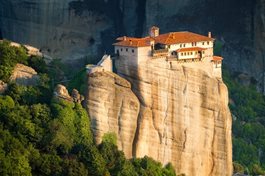
A prolonged study of history introduces you to people who make you feel like you just don’t get enough done in a day. In this category the builder-monks of Meteora have a special place. This astonishing Orthodox Christian monastic complex, perched on the pinnacles of 1200-foot high rock formations, soars high above the broad plain of ancient Thessaly.
The rocks of Meteora, which means, “suspended in air,” are much older than Christianity. Created by millennia of corrosion of silt and rock some 10-million years ago when Thessaly was a large estuary, the “rock forest” was considered the playthings of the Olympian Gods by ancient Greeks, while early Christians were convinced that they had fallen from heaven by some miracle. The windswept desolation of Meteora provided the ideal hermitage for 11th-century monks seeking a closer relationship with God. Retreating from the worldly excess and political chaos of the Byzantine Empire, at first the monks lived solitary lives in constant prayer in carved into the face of the rocks by centuries of wind. In the 14th century, however, in retreat from the turmoil of the dissolving Byzantine Empire, the hermits banded together to conceive of a monastic complex built on the pinnacle of the rocks. There, they reasoned, they would find the ultimate retreat, a place to devote their lives to prayer and contemplation as close to Heaven as they imagined possible on earth.
Only sincere and zealous faith could have enabled them to execute the engineering challenge that lay before them. For decades, the monks moved building materials up the steep, wind-battered heights of the rocks, using ropes and pulleys, treacherous rope ladders, donkeys, and the strength of their own backs. Legend has it that for the construction of the Monastery of Varlaam it took twenty-two years to haul the building materials up to the site, while the actual construction of the monastery took a mere twenty days. This may be a slight exaggeration, but the determination of the monks - as well as the climb up - leaves one breathless today.
Meteora soon attracted monks, nuns, and hundreds of pilgrims; achieving popularity in Greece that to this day is second only to the holiest monastery at Mount Athos. The safety, security, and solitude of Meteora were protected by its inaccessibility: the only way up to the top was by means of a wicker basket, attached to a windlass, pulled by ropes, which the monks believed should only be replaced, “when the Lord allows them to break.” The faithful were apparently willing to brave the harrowing ascent to experience the spirituality that many believe is still present today. Sustained by donations of food from the local population on the ground, and the tithes of pilgrim visitors up top, Meteora thrived. Between the 14th and 16th-centuries, the number of monasteries grew to 24, of which six remain active today: Great Meteoron, The Holy Trinity Monastery, Roussanou, Saint Nikolas, Varlaam, and Saint Stephanos.
Though Meteora was conceived and constructed by its builders as a refuge and retreat from the world, as Greece fought for independence against the Ottomans in the 17th - 19th centuries, the monasteries became an essential center of both national and cultural identity as well as a safe hiding place for the country’s independence fighters.
Today only a handful of monks and nuns remain at the six monasteries, men, and women who have dedicated their lives to extreme solitude, prayer, and contemplation just as their antecedents did. Modern-day pilgrims avail themselves of the far-less frightening stairs that have taken the place of the medieval windlass to climb up and experience the enduring magnificence and mystery that is Meteora.
Follow the footsteps of medieval pilgrims to Meteora on Alexander + Roberts’s popular itinerary,
Undiscovered Greece, a journey into the heart of fascinating Balkan culture and history, always capped at 16 guests to ensure your maximum enjoyment.